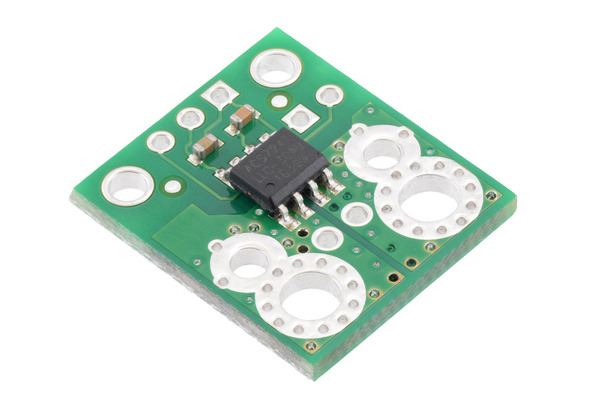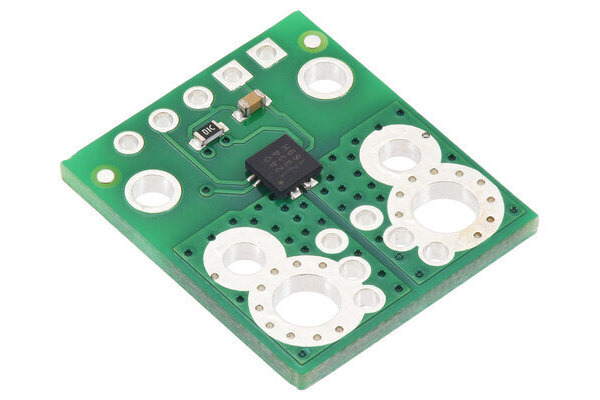Electronics » Sensors »
Current Sensors
 |
Our bidirectional and unidirectional current sensors are a simple way to gain fundamental insight into the performance of your system. You can use them for closed-loop torque control of actuators, tracking power consumption over time, load detection, over-current fault protection, or even as inexpensive current probes for an oscilloscope. We are offering these breakout boards with support from Allegro Microsystems.
These current sensors output an analog voltage that varies linearly with the current passing through them and offer full electrical isolation of the current path from the sensor’s electronics. This method of sensing means the sensor can be inserted anywhere into the current path, including on the high side, and because their current path resistance is on the order of 1 mΩ or less, they have minimal effect on the rest of the system.
All of our current sensor carrier boards (also called breakout boards) feature multiple options for making connections. For low-current applications, they all include at least one pair of through-holes compatible with 0.1″ male header pins, and for higher-current applications, the larger through-holes can be used for either soldering wires directly to the board or connecting solderless ring terminals.
The comparison table below summarizes our selection of active and preferred current sensors:
 |
 |
 |
 |
 |
 |
 |
 |
|
|---|---|---|---|---|---|---|---|---|
| CT220 Contactless Current Sensor Carriers |
ACS3704x Current Sensor Micro Carriers |
ACS3704x Current Sensor Compact Carriers |
ACS711 Current Sensor Carriers |
ACS71240 Current Sensor Carriers |
ACS724 Current Sensor Carriers |
ACS37030 Current Sensor Compact Carriers |
ACS37220 Current Sensor Compact Carriers |
|
| Allegro Sensor | CT220xMV-HS5 | ACS3704x | ACS711KEXT | ACS71240 | ACS724LLCTR | ACS37220 | ACS37030 | |
| Sensing technology | XtremeSense™ TMR (tunneling magnetoresistance) |
Hall effect | Hall effect | Hall effect | Hall effect | Hall effect + inductive coil | Hall effect | |
| Logic voltage range | 2.7–5.5 V | 3.3V versions: 3.0–3.6 V 5V versions: 4.75–5.5 V |
3.0–5.5 V | 3.3V ver: 3.0–3.6 V 5V ver: 4.5–5.5 V |
4.5–5.5 V | 3.0–3.6 V | 3.3V ver: 3.15–3.45 V 5V ver: 4.5–5.5 V |
|
| Family current range | 10–800 A | 10–30 A | 15.5–31 A | 10–50 A | 2.5–50 A | 20–65 A | 100–200 A | |
| Range/sensitivity of individual versions | (2) ±1.5 mT / 1500 mV/mT ±15 mT / 150 mV/mT |
ACS37041: 3.3V Bidirectional: ±10 A / 132 mV/A ±30 A / 44 mV/A 5V Bidirectional: ±10 A / 200 mV/A ±30 A / 66.7 mV/A ACS37042: 3.3V Bidirectional: ±10 A / 132 mV/A ±30 A / 44 mV/A 5V Bidirectional: ±10 A / 200 mV/A ±30 A / 66.7 mV/A |
ACS37041: 3.3V Bidirectional: ±10 A / 132 mV/A ±30 A / 44 mV/A 5V Bidirectional: ±10 A / 200 mV/A ±30 A / 66.7 mV/A ACS37042: 3.3V Bidirectional: ±10 A / 132 mV/A ±30 A / 44 mV/A 5V Bidirectional: ±10 A / 200 mV/A ±30 A / 66.7 mV/A |
Bidirectional:(1) ±15.5 A / 90 mV/A ±31 A / 45 mV/A |
3.3V Bidirectional: ±10 A / 132 mV/A ±30 A / 44 mV/A ±50 A / 26.4 mV/A 5V Bidirectional: ±10 A / 200 mV/A ±30 A / 66 mV/A ±50 A / 40 mV/A 5V Unidirectional: 0–50 A / 80 mv/A |
5V Bidirectional:(2) ±2.5 A / 800 mV/A ±5 A / 400 mV/A ±10 A / 200 mV/A ±20 A / 100 mV/A ±30 A / 66 mV/A ±50 A / 40 mV/A 5V Unidirectional:(2) 0–5 A / 800 mv/A 0–10 A / 400 mv/A 0–20 A / 200 mv/A 0–30 A / 133 mV/A |
3.3V Bidirectional: ±20 A / 66 mV/A ±40 A / 33 mV/A ±65 A / 20.3 mV/A |
3.3V Bidirectional: ±100 A / 13.2 mV/A ±150 A / 8.8 mV/A 5V Bidirectional: ±100 A / 20 mV/A ±150 A / 13.3 mV/A ±200 A / 10 mV/A |
| IC current path resistance | N/A | 1.6 mΩ | 0.6 mΩ | 0.6 mΩ | 0.6 mΩ | 0.7 mΩ | 0.1 mΩ | |
| PCB | N/A | 2 layers, 1-oz copper |
2 layers, 2-oz copper |
2 layers, 2-oz copper |
2 layers, 2-oz copper |
2 layers, 2- or 4-oz copper(3) |
2 layers, 2-oz copper |
2 layers, 2-oz copper |
| Max bandwidth | 30 kHz | 150 kHz | 100 kHz | 120 kHz | 120 kHz(4) | 5 MHz | 150 kHz | |
| Size | 0.4″ × 0.62″ | 0.3″ × 0.4″ | 0.7″ × 0.8″ | 0.7″ × 0.8″ | 0.7″ × 0.8″ | 0.7″ × 0.8″ | 0.7″ × 0.8″ | 0.7″ × 0.8″ |
| Overcurrent fault output |
User-configurable threshold | |||||||
| Common-mode field rejection | ||||||||
| Nonratiometric output | ||||||||
| 1-piece price | $4.95 | $4.15 – $4.69 | $4.45 – $4.99 | $4.85 | $5.25 | $9.95 – $11.49 | $11.95 | $6.95 |
Note 1: Sensitivity when Vcc = 3.3 V; actual sensitivity is ratiometric (i.e. it is proportional to Vcc).
Note 2: Sensitivity when Vcc = 5 V; actual sensitivity is ratiometric (i.e. it is proportional to Vcc).
Note 3: 50A version of this carrier uses 4-oz copper PCB; all other versions of this carrier use 2-oz copper.
Note 4: Bandwidth can be reduced by adding a filter capacitor.
Note 1: Sensitivity when Vcc = 3.3 V; actual sensitivity is ratiometric (i.e. it is proportional to Vcc).
Note 2: Sensitivity when Vcc = 5 V; actual sensitivity is ratiometric (i.e. it is proportional to Vcc).
Note 3: 50A and higher versions of this carrier use a 4-layer PCB; all other versions of this carrier use a 2-layer PCB.
You can also use the following selection box to see these options sorted by current range:
Alternatives available with variations in these parameter(s): current range Select variant…
 Compare all products in this category
Compare all products in this category
Subcategories
Monitor voltage, current, power, and other parameters in AC and DC systems with these boards featuring Allegro’s ACS37800KMACTR-030B3-I2C isolated power monitoring IC. They provide bidirectional current measurements from -30 A to +30 A and can be configured to measure voltages up to 480 VRMS nominal (±980 V peak).
These boards are simple carriers of Allegro’s contactless current sensors, which measure the magnetic field of the current flowing through a nearby conductor without needing to be connected in series with the circuit. They output an analog voltage proportional to the magnetic field that with simple calibration can be converted into an accurate current measurement.
These boards are simple carriers of Allegro’s high-dV/dt, high bandwidth (1 MHz) CT432/CT433 tunneling magnetoresistance (TMR) current sensors, which output an analog voltage proportional to the current passing through them. They offer common-field mode rejection, a low-resistance (~1 mΩ) current path, and overcurrent fault. 3.3V and 5V versions are available.
These boards are simple carriers of Allegro’s high-current ACS72981 Hall effect-based, galvanically isolated current sensors, which output an analog voltage proportional to the current passing through them. They offer differential sensing, a low-resistance (~0.2 mΩ) current path, and a high 250 kHz bandwidth. 3.3V and 5V versions are available.
These boards are simple carriers of Allegro’s high-current ACS37220 Hall effect-based, galvanically isolated current sensors, which output an analog voltage proportional to the current passing through them. They offer differential sensing, an extra-low-resistance (~0.1 mΩ) current path, and configurable overcurrent fault. 3.3V and 5V versions are available.
These boards are simple carriers of Allegro’s 3.3V ACS37030 DC to 5 MHz bandwidth, galvanically isolated current sensors, which output an analog voltage proportional to the current passing through them. They offer differential sensing for higher accuracy, a low-resistance (~0.7 mΩ) current path, and a zero-current reference output.
These boards are simple carriers of Allegro’s 5V ACS724 Hall effect-based, galvanically isolated current sensors, which output an analog voltage proportional to the current passing through them. They offer differential sensing for higher accuracy and a low-resistance (~0.6 mΩ) current path.
These boards are simple carriers of Allegro’s ACS71240 Hall effect-based, galvanically isolated current sensors, which output an analog voltage proportional to the current passing through them. They offer differential sensing for higher accuracy and a low-resistance (~0.6 mΩ) current path. 3.3V and 5V versions are available.
These boards are simple carriers for Allegro’s ACS37041/2 Hall effect-based, galvanically isolated current sensor in a 5-pin SOT-23 package with ~1.6 mΩ current path resistance, differential sensing, and 150 kHz bandwidth. 3.3V and 5V versions are available with up to ±30A current range.
These boards are simple carriers of Allegro’s ACS711 Hall effect-based, galvanically isolated current sensors, which work with both 3.3V and 5V supplies and output an analog voltage proportional to the current passing through them.
These are older current sensors on clearance and will be discontinued once remaining component stock is depleted.































